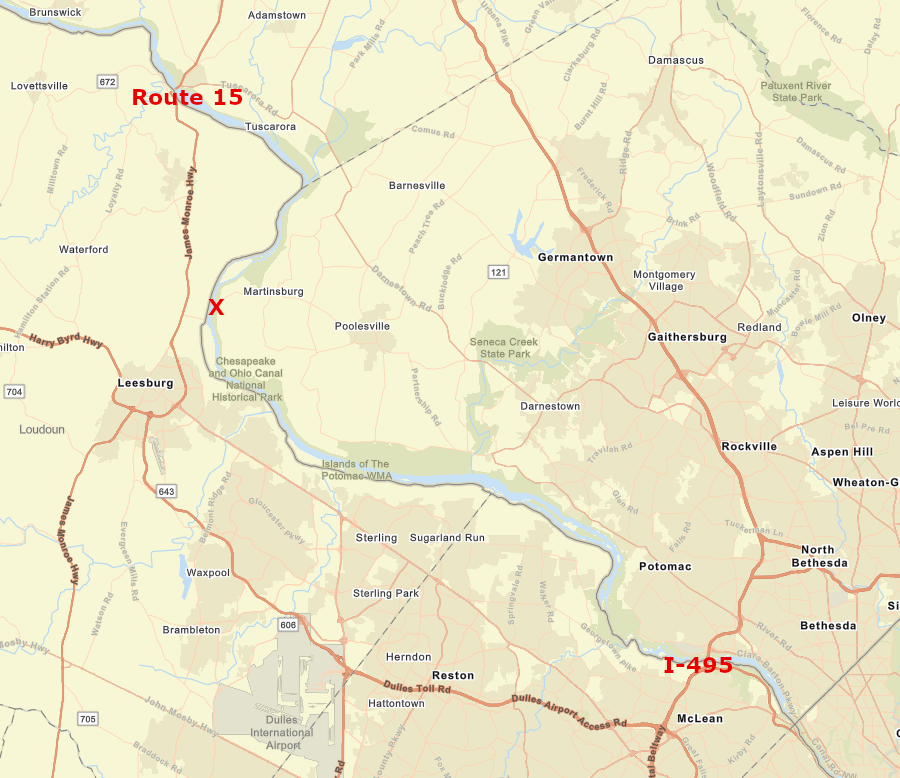
White's Ferry (red X) offered the only crossing of the Potomac River between American Legion Bridge (I-495) and Point of Rocks (Route 15)
Source: ESRI, ArcGIS Online

White's Ferry (red X) offered the only crossing of the Potomac River between American Legion Bridge (I-495) and Point of Rocks (Route 15)
Source: ESRI, ArcGIS Online
White's Ferry was the last survivor of 100 ferries that once operated on the Potomac River to carry vehicles between Maryland-Virginia. Above Great Falls, Peter Stephens started operating a ferry where the Potomac River passed through the Blue Ridge in 1732/1733. Robert Harper took it over in 1747, and is remembered by the place name of Harper's Ferry today.
Ferries crossing the Potomac River have a long history, but all have shut down now. Some have been replaced by bridges.
White's Ferry was originally started as Conrad's Ferry. It was authorized by Maryland's General Assembly in 1782 and began operating around four years later. A boat was attached to a 300-yard cable stretched across the river and pulled by hand to carry horses, wagons, and passengers across the Potomac River. Conrad's Ferry became known as White's Ferry soon after the Civil War, even before former Confederate officer Lt. Col. E.V. White acquired it.
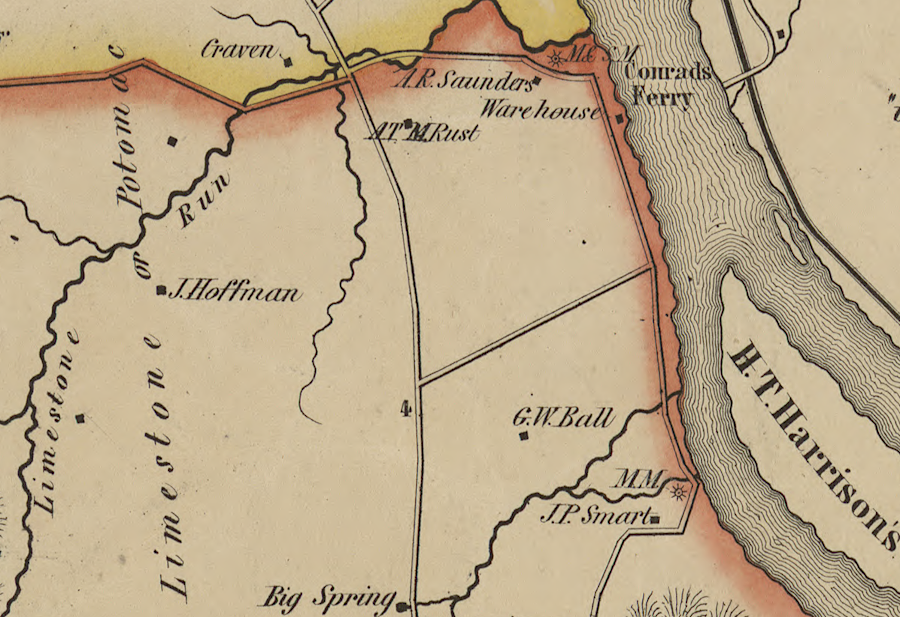

what is now known as White's Ferry was originally started as Conrad's Ferry
Source: Library of Congress, Map of Loudoun County, Virginia (by Yardley Taylor, 1854); Map of n. eastern Virginia and vicinity of Washington ("McDowell Map" by Joseph Schedler, 1862)
New owners purchased the ferry in 1946. The first ferry was a segment of a World War II pontoon bridge. The first actual ferry boat was purchased in 1953, then replaced in 1988.
Each boat was named the "Jubal Early" in honor of a Confederate general. He had led an army into Maryland in July, 1864. After marching downstream beyond the ferry, the Confederates attacked Washington, DC from the north. Early's attack was repulsed, and a year later he fled to Mexico after the end of the Civil War. Though he returned to the United States in 1869, Early never swore allegiance again to the Union. The ferry operators admired his "no surrender" attitude.1
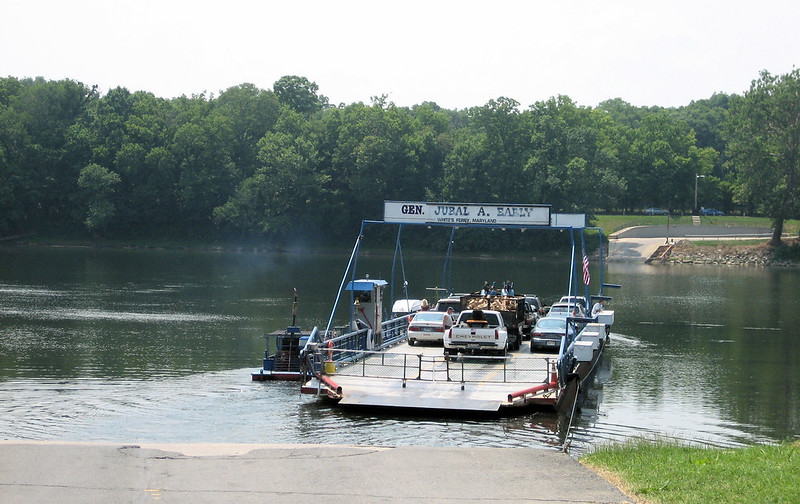
between 1953-2021, the boats at White's Ferry were named after Confederate General Jubal Early
Source: Flickr, Jubal A. Early ferry (by Thomas Cizauskas)
White's Ferry allowed cars and light trucks to cross the Potomac River between Poolesville, Maryland and US 15 in Loudoun County. It was a shortcut for commuters with high-tech jobs who lived in Maryland upstream of the American Legion Bridge (I-495) and worked near Dulles International Airport, and for Loudoun County residents with jobs along the I-270 corridor or in Bethesda, Maryland. Its busiest days were on weekends, when people were recreating and shopping.
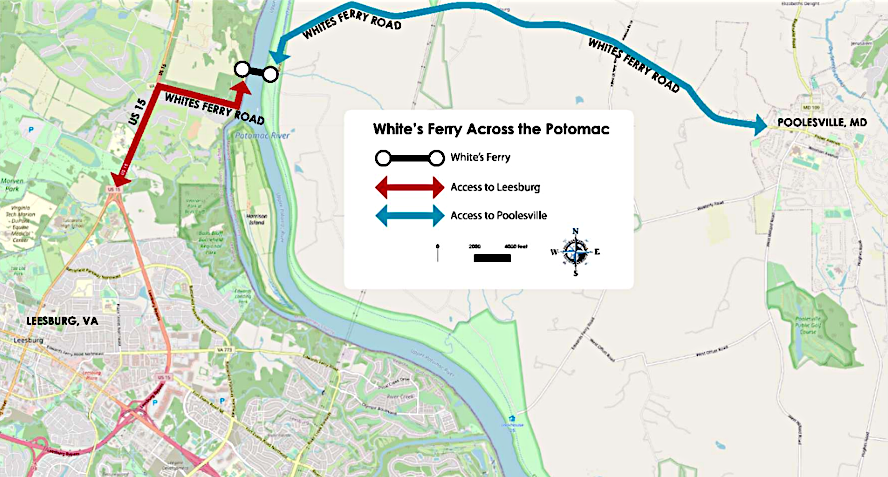
White's Ferry transported commuters between Maryland and Virginia until service stopped on December 28, 2020
Source: Loudoun County, November 2021 Staff Report and White's Ferry Study (Figure 3-1)
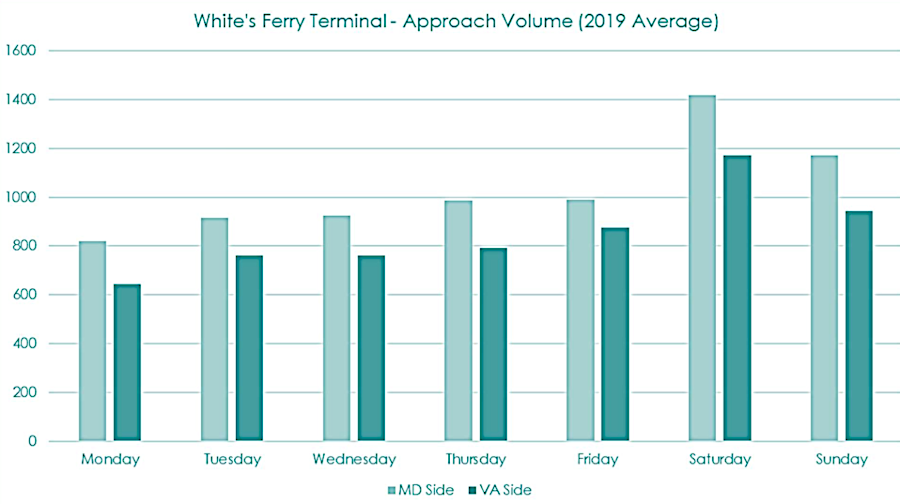
White's Ferry was busy on Saturdays and Sundays, as well as on weekdays when commuters used it
Source: Loudoun County, November 2021 Staff Report and White's Ferry Study (Figure 3-7)
A property dispute led to White's Ferry closing on December 28, 2020. On the Loudoun County side of the river, the ferry landing was on private property. Elijah White had renamed Conrad's Ferry after the Civil War, and Loudoun County acquired land in 1871 for a ferry landing. However, there was no documentation of the location of that public property. The Brown family acquired White's Ferry in 1946 and purchased land on the Maryland side, but the landing site in Virginia was located on the property of Rockland Farm. It licensed use of the landing starting in 1952.
The relationship cracked after the ferry landing was expanded without authorization in 2004. After Hurricane Isabel destroyed a wooden wall on the Virginia landing, the ferry operators replaced it with a concrete retaining wall. They assumed their repair was within a public right-of-way.
The owners of Rockland Farm claimed there was no public right-of-way and that the entire landing was on their private land. In 2020, Rockland Farm won a long-delayed lawsuit; the Loudoun Circuit Court judge ruled the ferry operator had no right to use the landing and had to pay $102,175 to remove the retaining wall.
Rockland Farm followed up with offers to license the ferry at a new fee or to purchase White's Ferry. The operator claimed the offers were financially unrealistic, and that the demand for $18,000 a month to use the landing exceeded the entire monthly revenue from operating the ferry. A proposal for $1.00/car would have diverted 38% of the gross revenue per car, assuming fees remained at $2.62 per trip for daily commuters.
The ferry operator also claimed that Rockland Farm's proposal that the revenues be split evenly (1/3 each) between the landowner on the Virginia shore, the landowner on the Maryland shore, and the operator would have left the operator without adequate funding to pay annual costs. The operator proposed $400,000 for an easement, and the counter-offer was $2,000,000 with the right for Rockland Farm to cancel the agreement with just 30 days notice.
The operator ultimately abandoned the fruitless negotiations and closed the business without warning. Since the ferry was the only crossing of the Potomac River for 35 miles between the Point of Rocks and American Legion bridges, closure disrupted the pattern of commuters.2
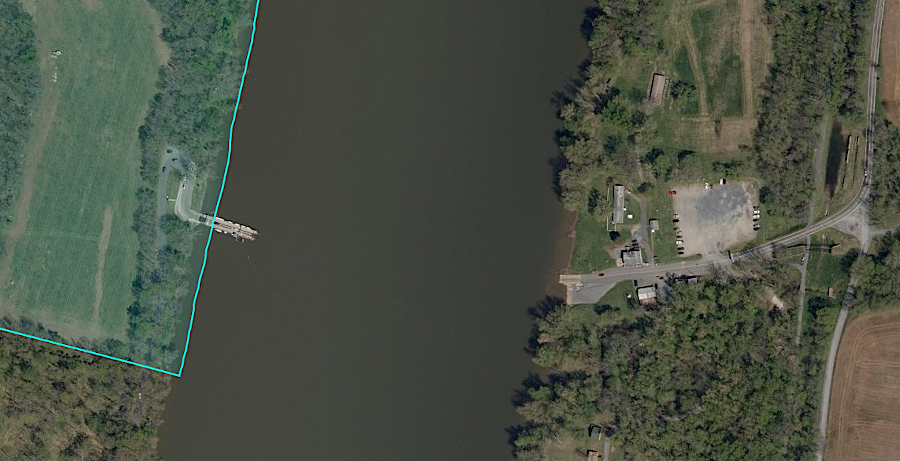
White's Ferry closed in 2020 after a dispute over rights to use the property of Rockland Farm (highlighted in blue) for a landing
Source: Loudoun County, WebLogis - Online Mapping System
Efforts to negotiate a deal between Rockland Farm and the ferry owner to reopen White's Ferry were not successful. In February, 2021, Chuck and Stacey Kuhn purchased the ferry business and all assets. The wealthy couple, owners of a large moving company, had already been deeply engaged in buying and conserving land in Loudoun County. They served the role of "white knight," and their acquisition was intended to facilitate reopening the ferry for the 800 daily users who were affected by the closure.3
The new owners failed to restart ferry operations quickly. The owners of Rockland Farm insisted on a payment of $0.50 per vehicle for the right to use their property on the Virginia side of the Potomac River. Rather than agree to the demand, the ferry owners proposed Virginia or Loudoun County condemn the ferry landing site, paying fair market value to convert the site from private into public property.
Once the landing site was owned by Loudoun County, it could negotiate a deal to authorize use by White's Ferry. The "taking" process, with various court filings, could take as long as 10 months before vehicles could be floated across the river. A judge would determine "fair market value," but the county could use its newly-acquired property while the legal process to determine value was underway.4
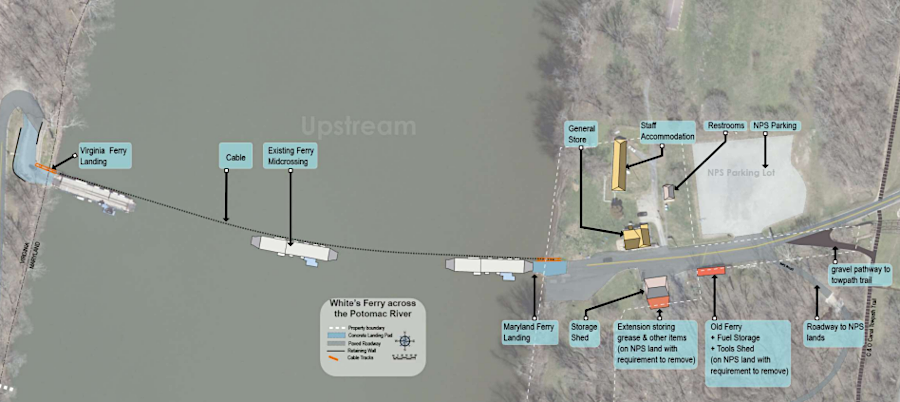
most facilities for White's Ferry, including the toll collection area, was on the Maryland side
Source: Montgomery County, White's Ferry Operations Alternative Study (Figure 1-3)
The new ferry owners kept pressing for Loudoun County to use its power of eminent domain to purchase the landing owned by Rockland Farm. The ferry owner stated in August, 2021:5
In October, 2021 the Loudoun County Board of Supervisors started the condemnation process. It removed 30 acres around the landing from the Agricultural and Forestal District:6
The county was interested in maximizing the return on its possible investment by increasing the number of cars who could cross the Potomac River each day. When privately run, the ferry made an average of four trips/hour. It took six minutes to load the ferry and six minutes to unload, plus three-and-a-half minutes to cross the river.
Road access ramps could be reconfigured to allow loading cars, installing an electronic payments system, and buying a larger boat (replacing the current one, which was two smaller ferries combined together) to accommodate more vehicles.7
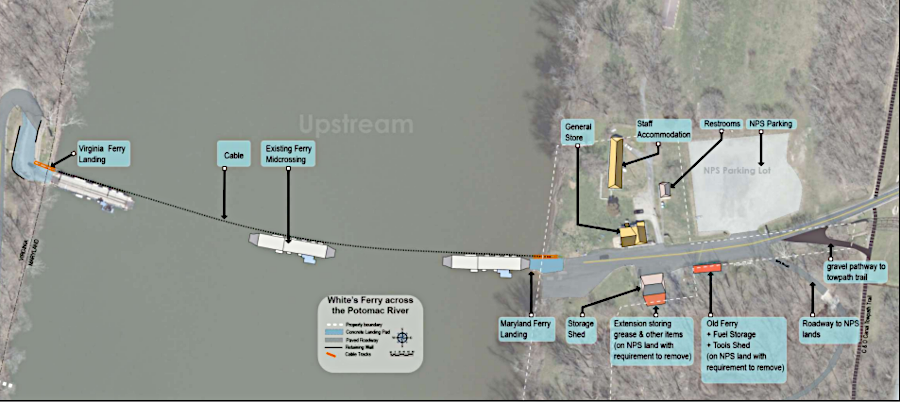
when operating, White's Ferry carried approximately 600 to 800 vehicles across the Potomac River each day
Source: Loudoun County, November 2021 Staff Report and White's Ferry Study (Figure 1-3)
Loudoun officials were less interested in restoring ferry service than Montgomery County officials. The peak use was on weekends rather than on workdays when commuters were crossing the river; Maryland wineries were beneficiaries of the ferry. Loudoun officials considered the ferry to be a minor fix for a more-significant transportation proposal to connect Route 7 in Virginia to I-70 in Maryland. Montgomery County was unwilling to support a new highway and associated development, cutting through the area in the county designated for large-lot agriculture.
One Loudoun supervisor framed the problem as a need to expand road capacity, rather than just restart a ferry that carried 800 people/day:8
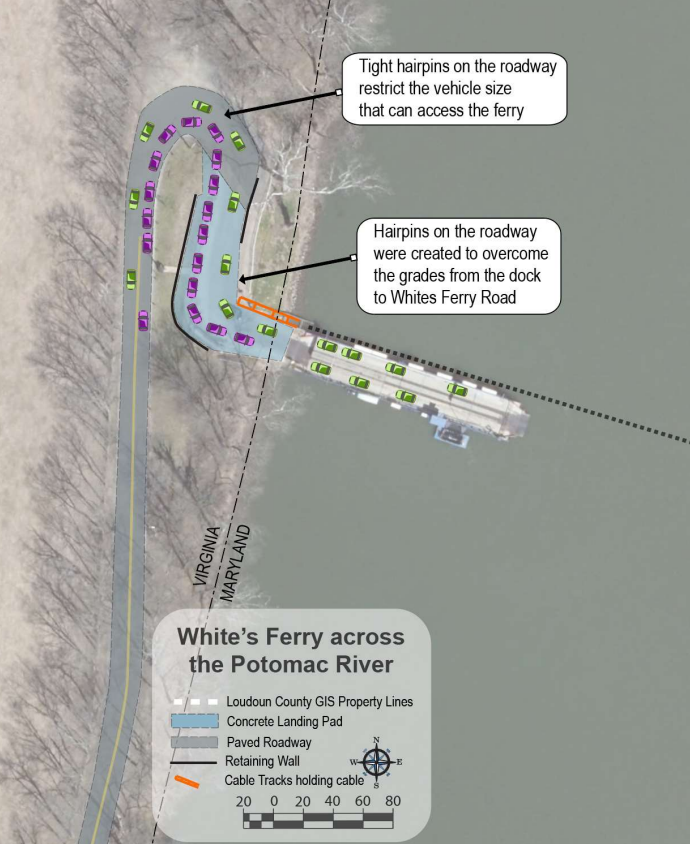
a hairpin turn at the Loudoun County landing limited the size of vehicles which could access White's Ferry
Source: Montgomery County, White's Ferry Operations Alternative Study (Figure 3-21)
The Montgomery County Executive responded that commuters should move to the side of the river where their job was located, rather than push for a bridge. Montgomery County had established an agricultural reserve in the western end of the county, zoning for housing on large (25-acre) parcels. In contrast, Loudoun County zoned its shoreline of the Potomac River to allow dense subdivisions, with housing for new commuters who created a demand for new transportation infrastructure.
Extension of the Metro Silver Line into Loudoun County provided mass transit to jobs east of Loudoun County, but a trip from Ashburn to the Red Line station at Shady Grove required 90 minutes. The Montgomery County Executive was blunt:9
A 2021 study by Loudoun County concluded that a publicly owned and privately operated ferry would be the most cost-effective:10
At the end of 2022, White's Ferry remained closed. There was no deal yet between the owners of Rockland Farm and Chuck and Stacey Kuhn, owners of White's Ferry and the Maryland landing site. The Kuhn's offer to purchase Rockland Farm for $13.5 million had failed.11
The owners of Rockland Farm insisted that any agreement to reopen the ferry include a volume-based fee, with each vehicle paying $0.50. The Kuhn business model for reopening assumed a one-time $1.1 million payment for landing rights on the Virginia shoreline, but not a per-vehicle fee. In March 2023, the Kuhn's put White's Ferry up for sale and announced:12
By 2024, the owners of White's Ferry concluded they could never negotiate a deal with the owners of Rockland Farm. They offered to donate White's Ferry to Montgomery County, so it could find a way to restart the ferry. Chuck Kuhn said:13
Montgomery County declined the donation, but in April 2025 it offered a financial subsidy to Rockland Farm and the Kuhns in order to break the deadlock and reopen ferry service. Maryland crafted a $3 million incentive package, funded 50% by the State of Maryland and 50% by the county and the Town of Poolesville. The offer included a July 1, 2026 deadline. The Montgomery County Executive wrote:14
The owner of White's Ferry then offered to donate the ferry to Loudoun County.14
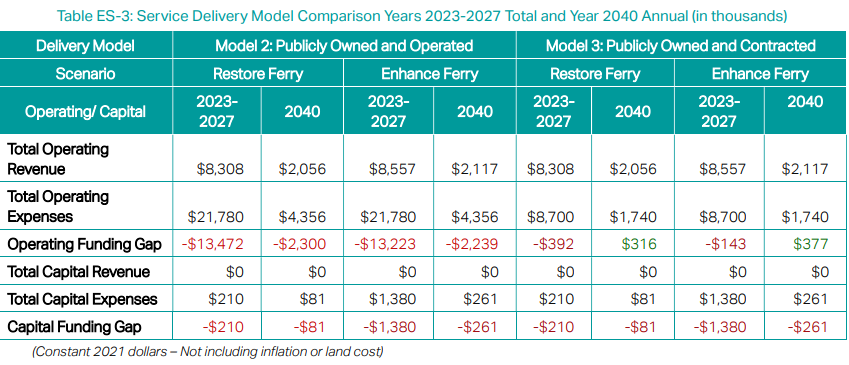
a publicly owned/privately operated ferry would be more cost-effective than a publicly owned/publicly operated ferry
Source: Loudoun County, November 2021 Staff Report and White's Ferry Study (Figure 3-21)
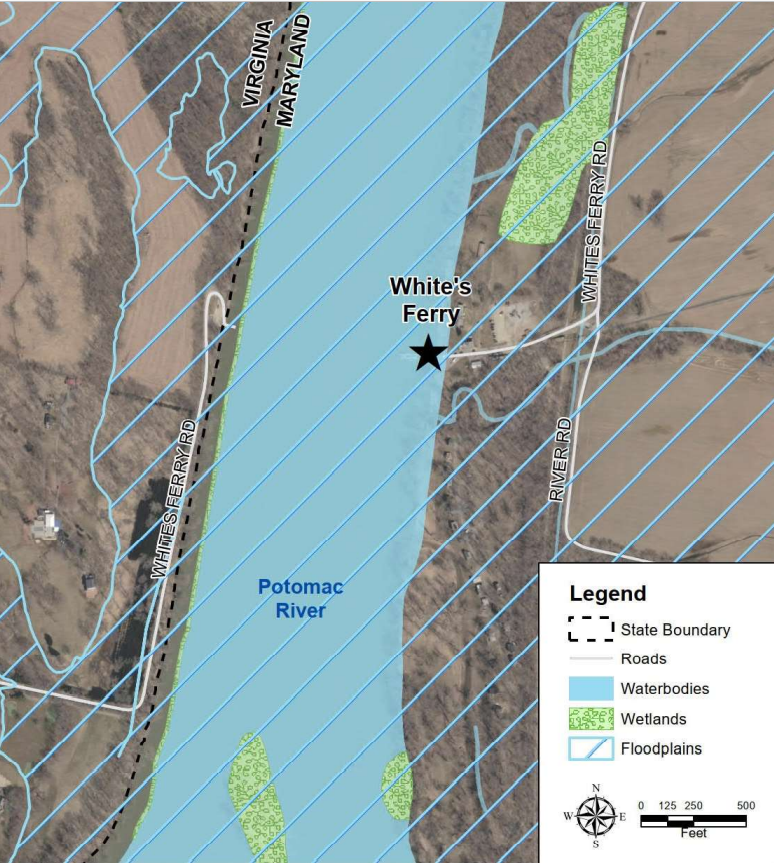
White's Ferry is located in the floodplain, complicating proposals for building new infrastructure
Source: Loudoun County, White's Ferry Operations Alternative Study (Table ES-3)
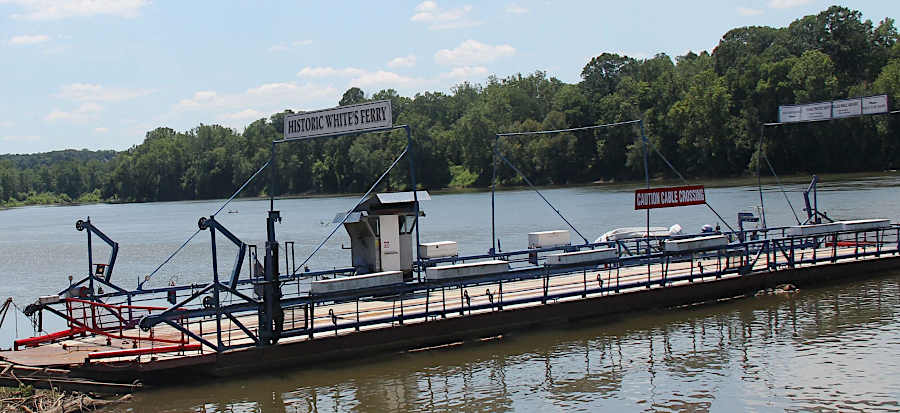
White's Ferry was two boats, bound together and pulled along a cable to cross the Potomac River
Source: Montgomery County, White's Ferry Operations Alternative Study (p.50)